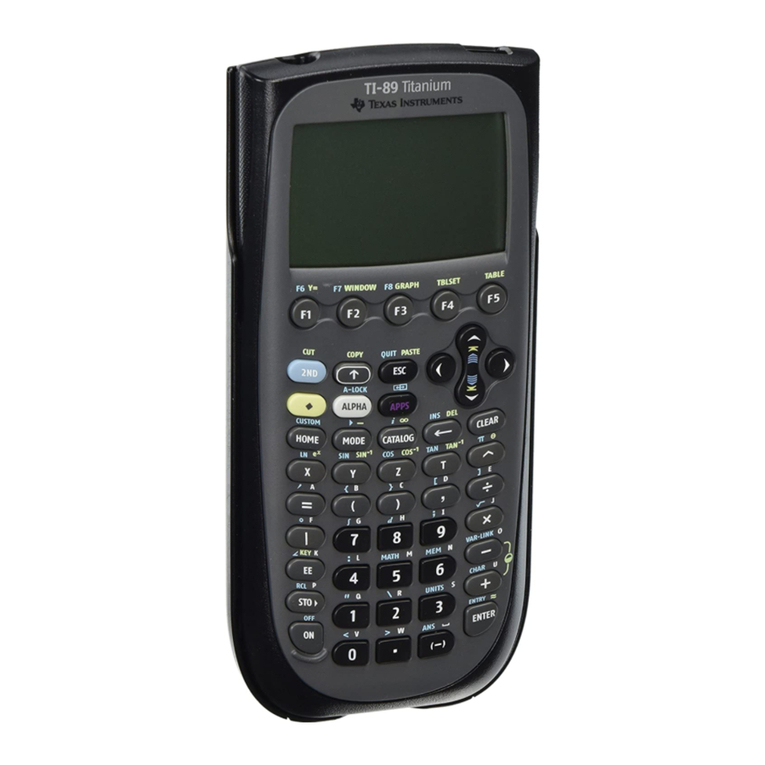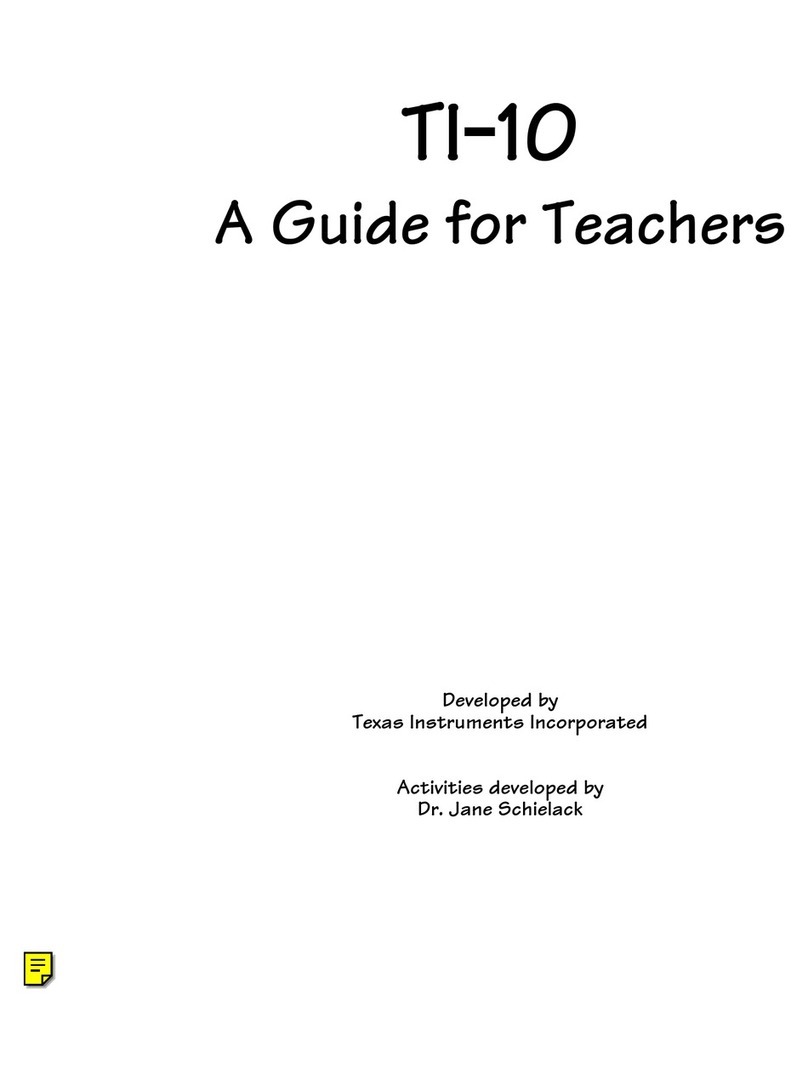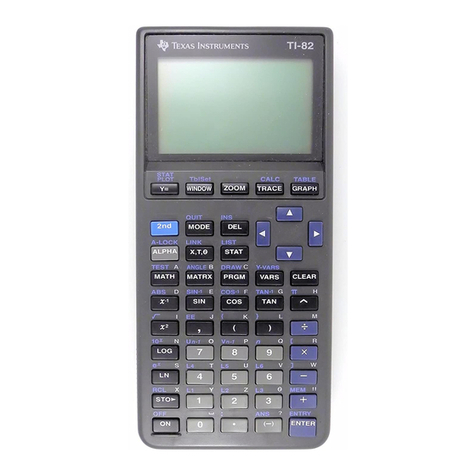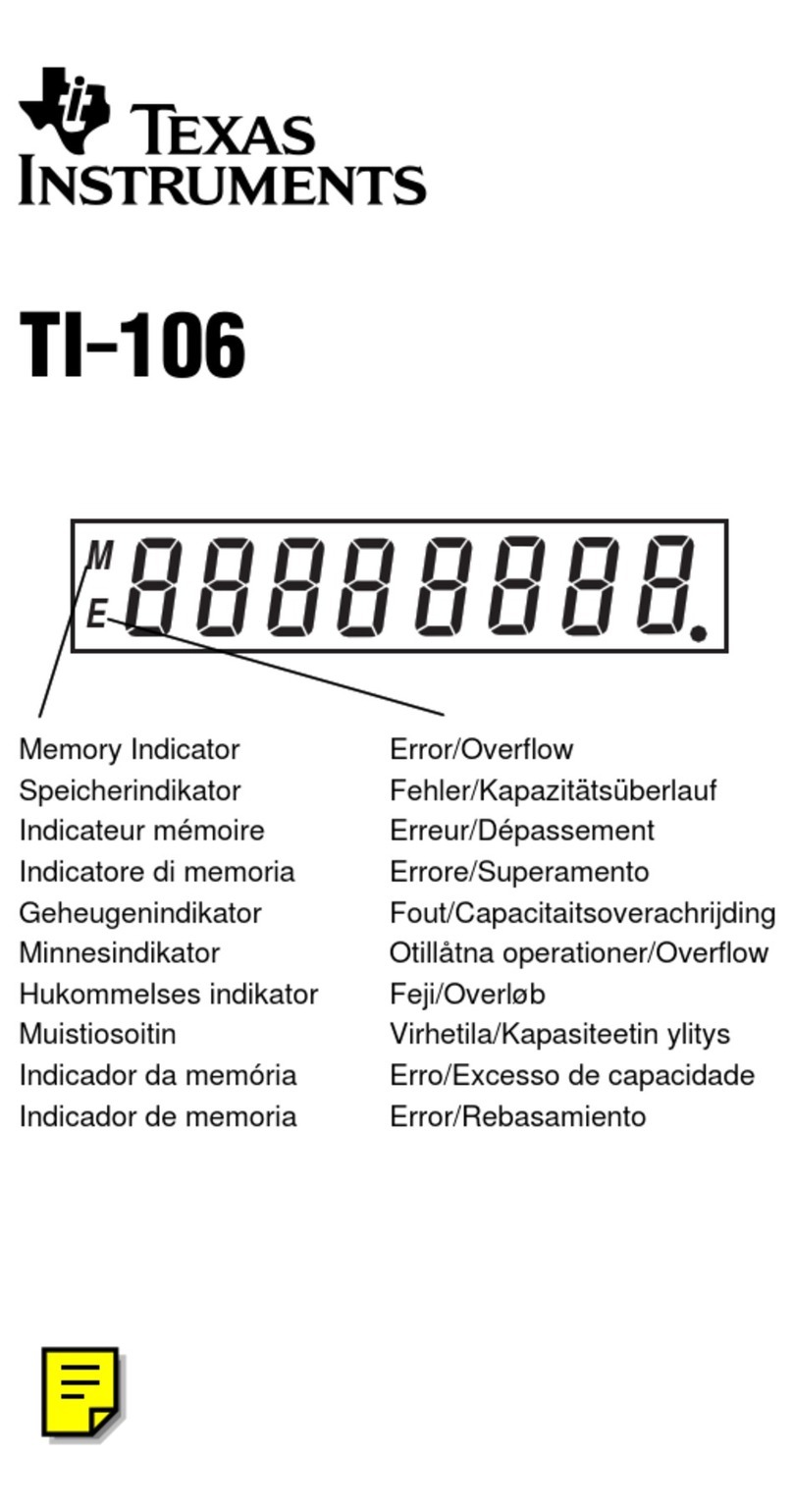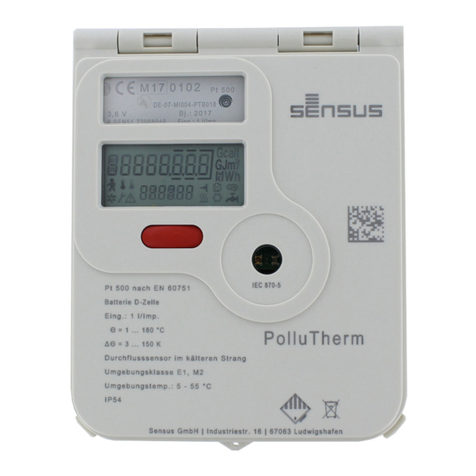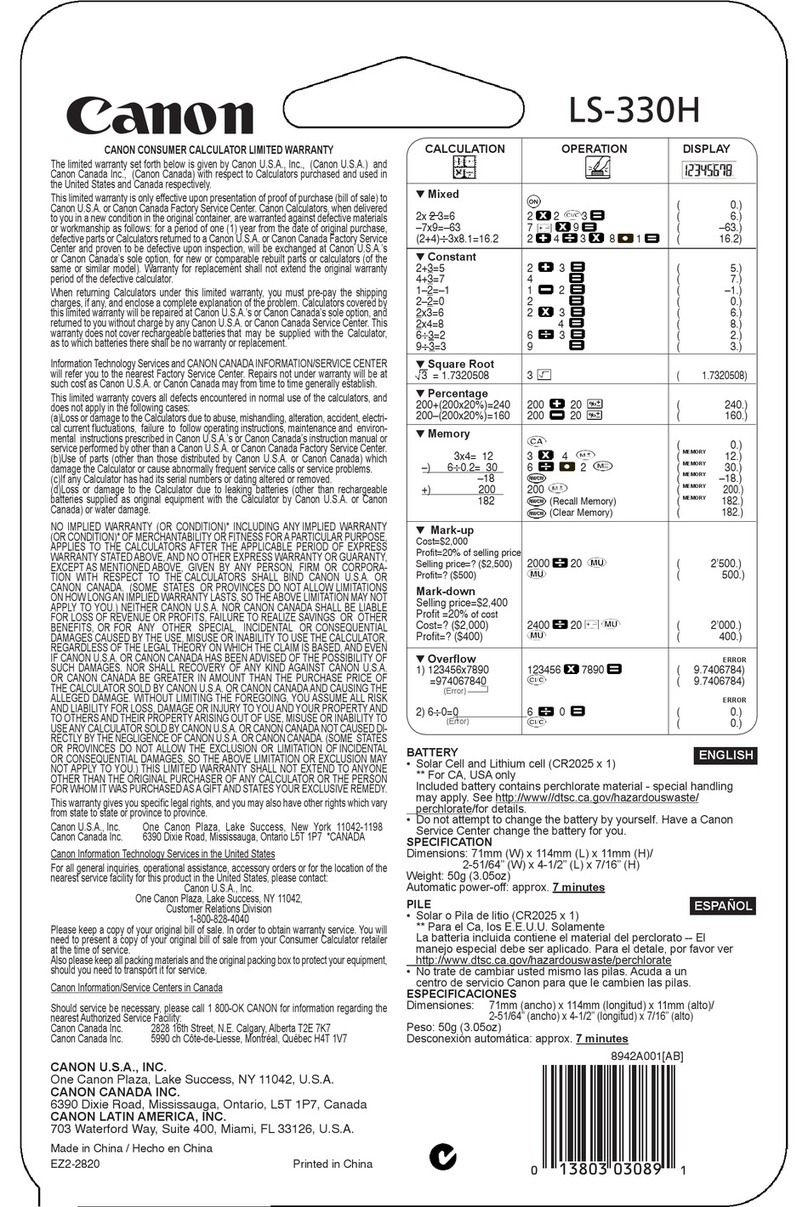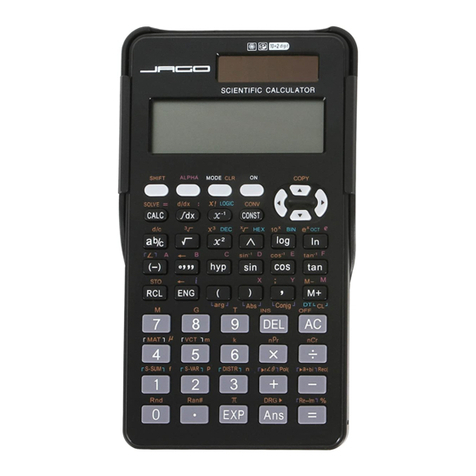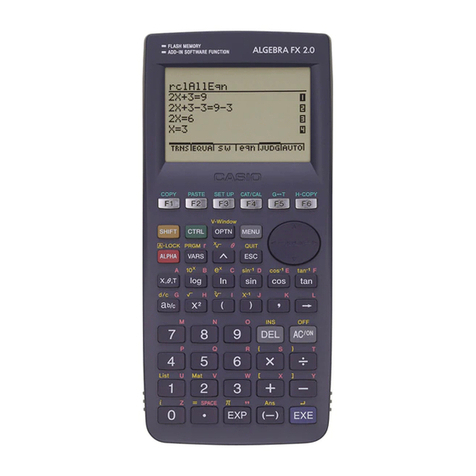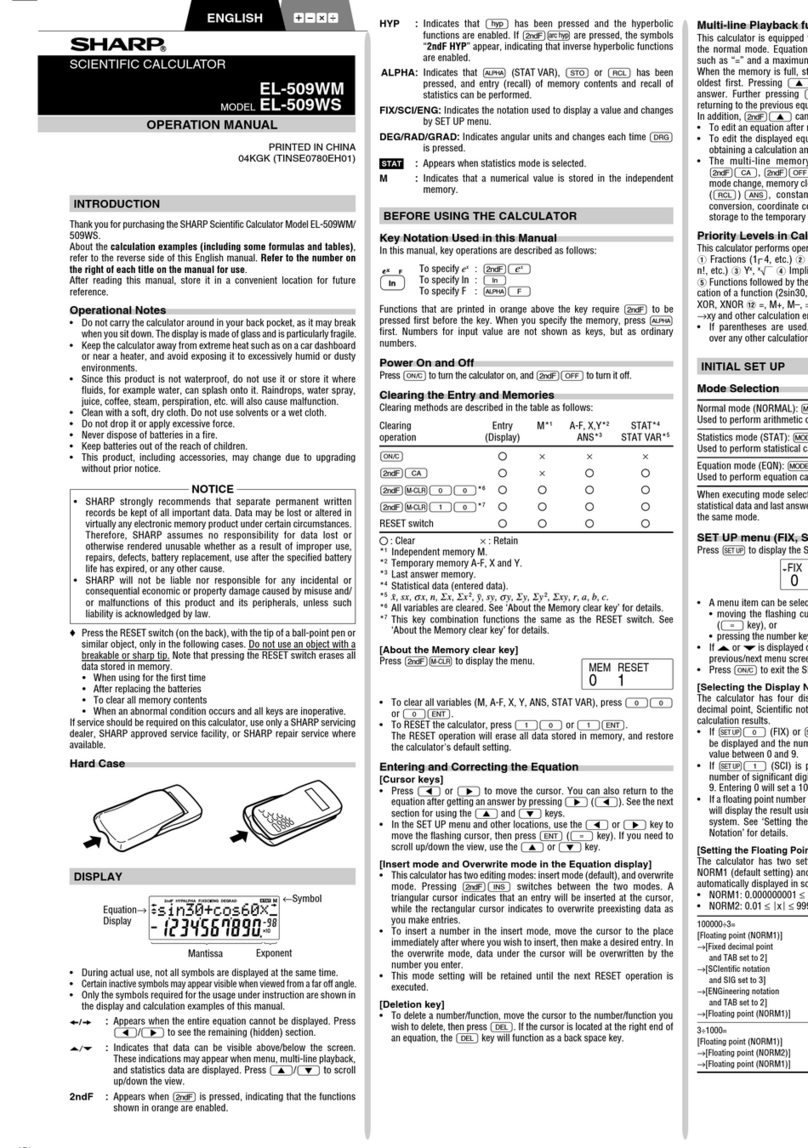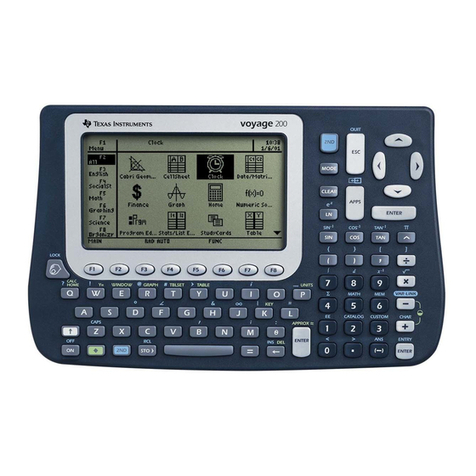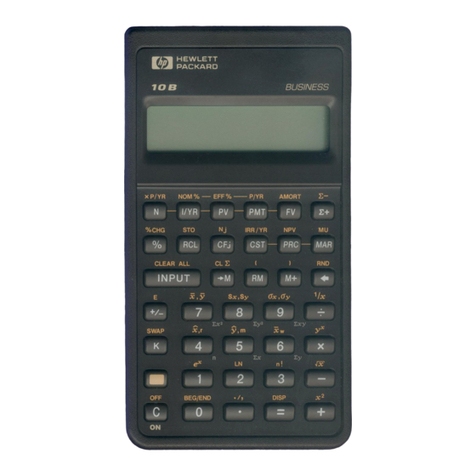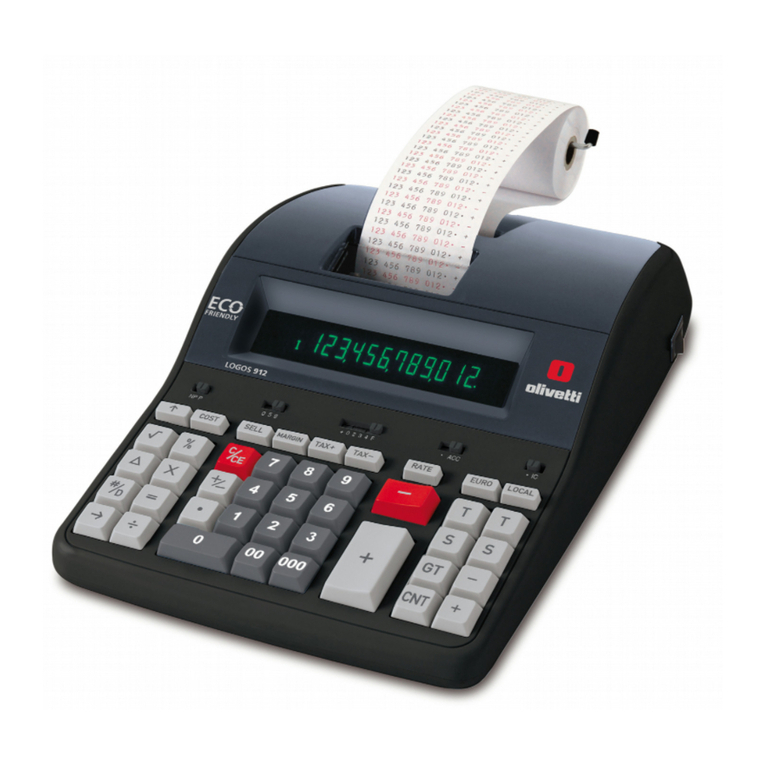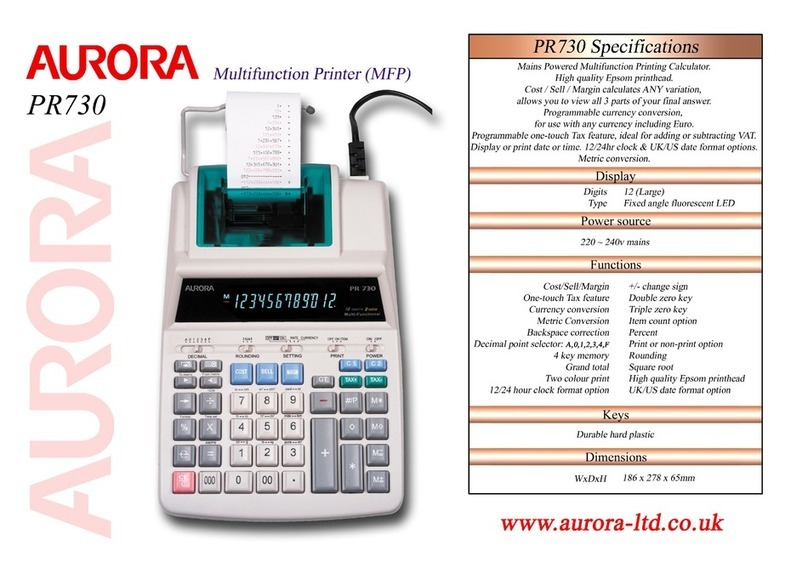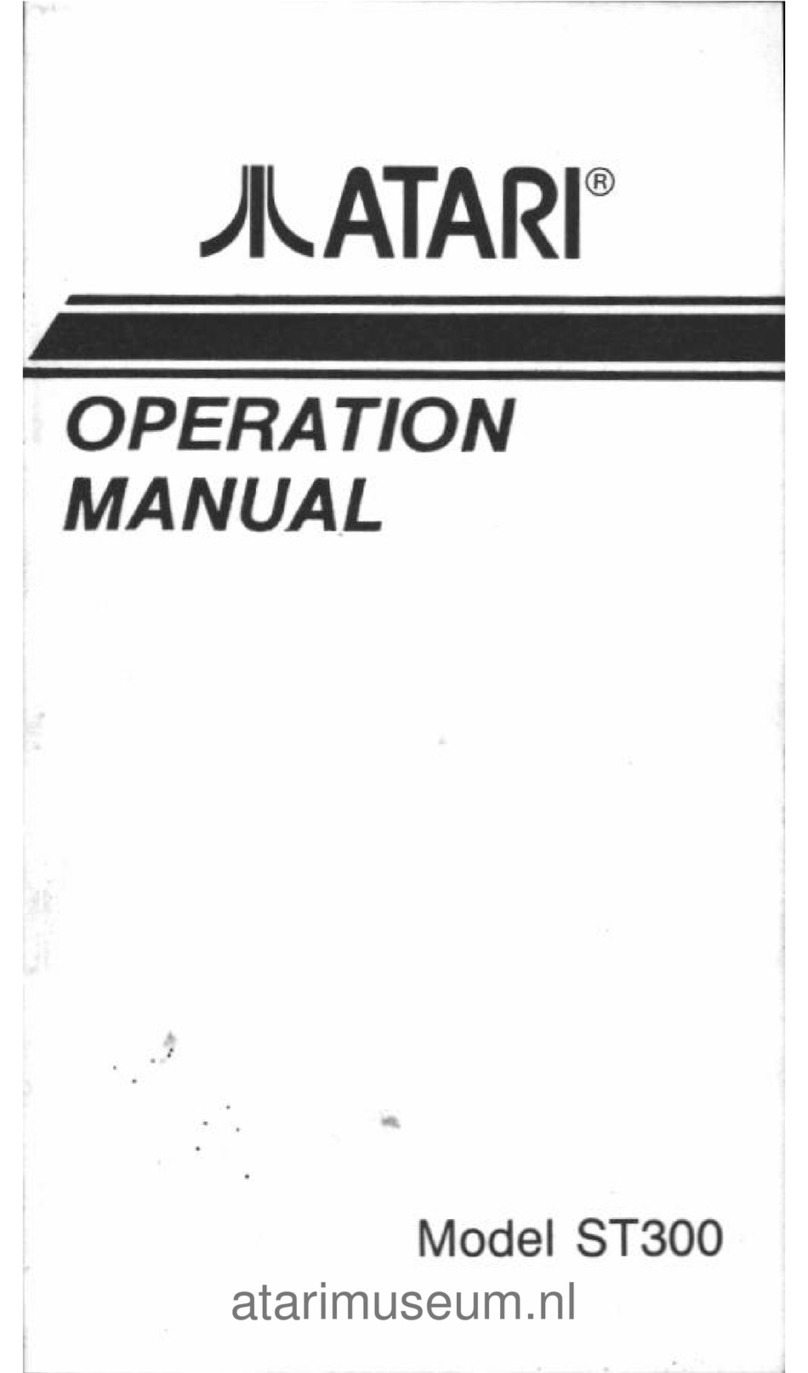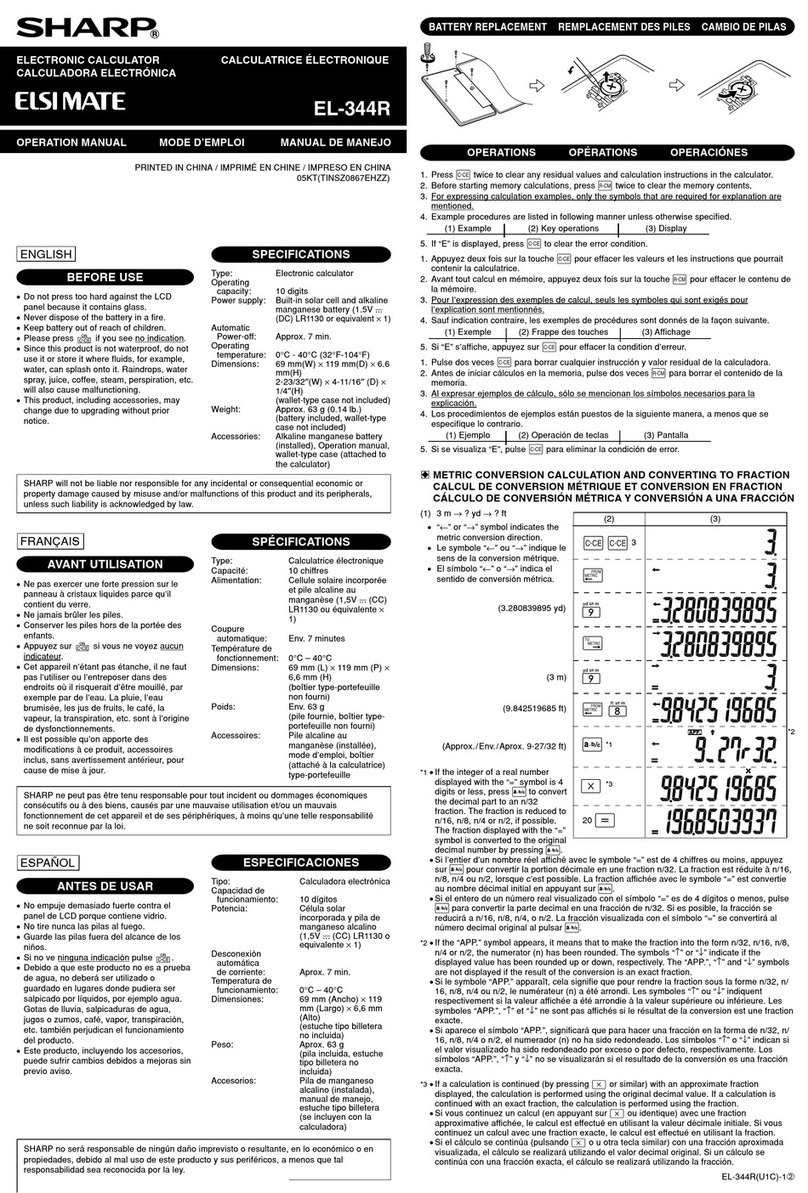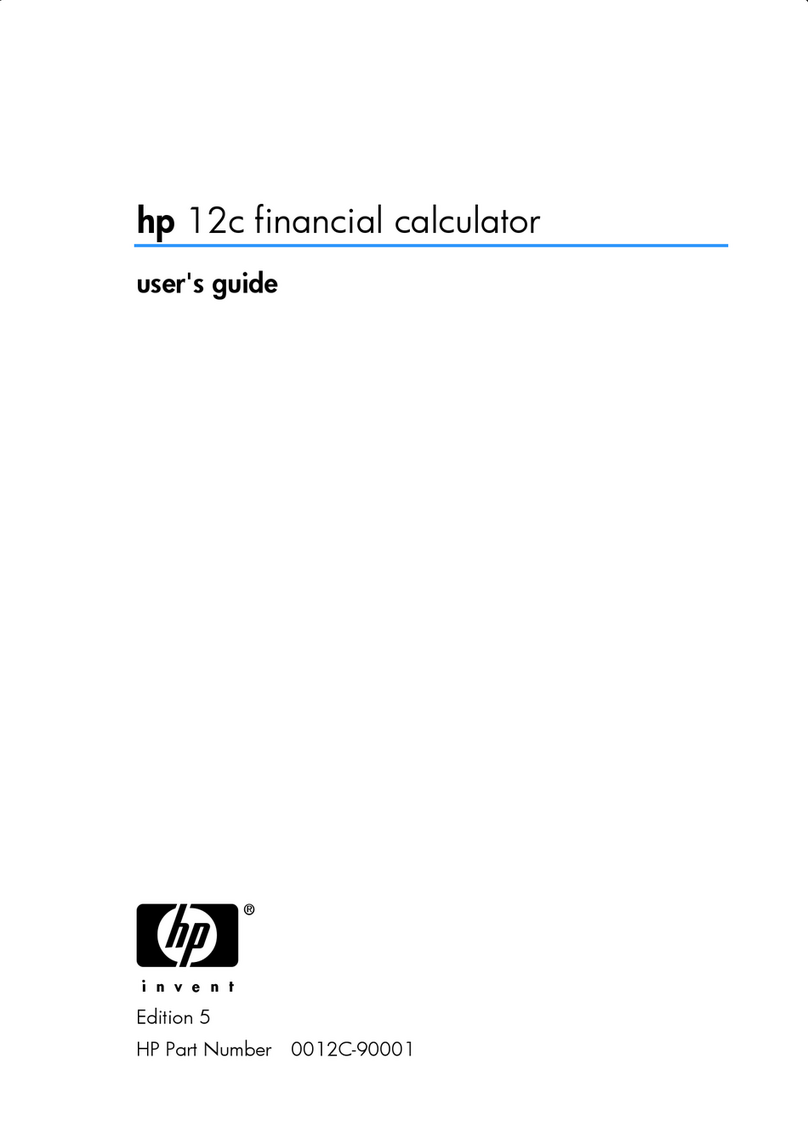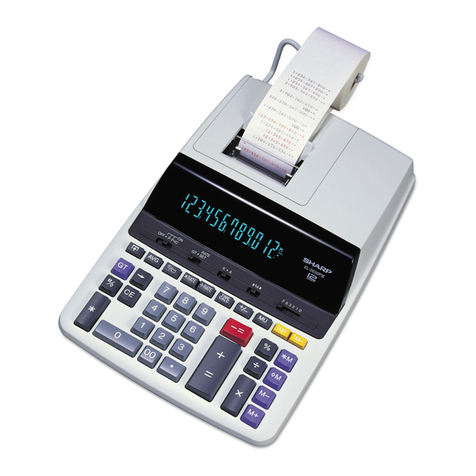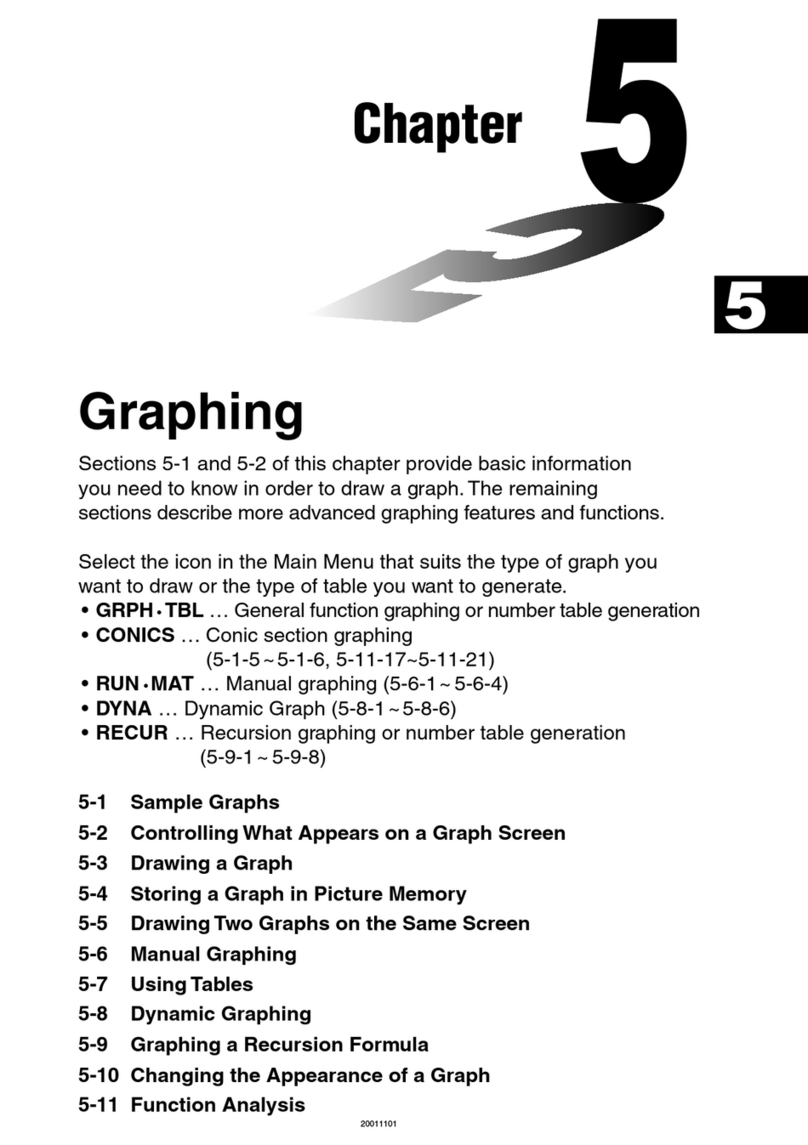TI 84 - Viewscreen Calc User manual

education.ti.com
TI-84 Plus Silver Edition Keyboard
key accesses the Handheld
Software Applications (Apps) loaded
on your TI-84 Plus Silver Edition
Éaccesses the alpha function
printed in green a ove each key
yaccesses the second function
printed in lue a ove each key
Operations keys
}~Ü| keys let you move
the cursor in four directions
ëerases (clears) the entry line
or deletes an entry and answer on
the home screen
Õevaluates an expression,
executes an instruction, or selects
a menu item
Special Features of the TI-84 Plus Silver Edition,
TI-84 Plus, and TI-83 Plus
Flash™— Electronic Upgradability
The TI-84 Plus Silver Edition, TI-84 Plus, and TI-83 Plus use Flash
technology, which lets you update your operating system and
add Handheld Software Apps, such as Topics in Alge ra 1, Inequality
Graphing, NoteFolio™, TImeSpan™, CellSheet™, and many more!
Comparing the TI- 4 Plus Silver Edition and the TI- 3 Plus
TI- 4 Plus Silver Edition TI- 3 Plus
Flash ROM 1.54 M 160 K
Holds up to 94 Apps 10 Apps
Preloaded Apps 18 4
Connectivity USB ca le included TI Connectivity USB
ca le sold separately
Case Color SILVER & Customizable Classic dark gray
Z 0 Processor Speed 15 MHz 6 MHz
RAM 24 K 24 K
TI Connectivity Kit
With the TI Connect™software and TI Connectivity USB ca le, you
can link your TI-84 Plus to a personal computer. As future software
updates ecome availa le on the TI we site, you can download
the software to your computer and use the TI Connect software
and TI Connectivity USB ca le to update your TI-84 Plus.
Getting to Know Your TI-84 Plu Silver Edition
Turning Your TI-84 Plus Silver Edition On and Off
To turn on your TI-84 Plus Silver Edition, press ….
■If you had previously turned off your TI-84 Plus Silver Edition y pressing
yM, it will display the home screen as it was when you last used it.
To turn off your TI-84 Plus Silver Edition manually, press yM.
■All settings and memory contents are retained y Constant Memory™.
To prolong the life of the atteries, Automatic Power Down™(APD™)turns
off your TI-84 Plus Silver Edition automatically after a out five minutes
without any activity.
Using the yand ÉKeys
The secondary function of each key is printed in lue a ove the key.
When you press the lue ykey, the character, a reviation, or word
printed in lue a ove the other keys ecomes active for the next
keystroke. For example, when you press yand then ç, the TEST
menu is displayed.
The alpha function of each key is printed in green a ove the key. When
you press the green Ékey, the alpha character printed in green
a ove the other keys ecomes active for the next keystroke. For
example, when you press Éand then ç, the letter A is entered.
Adjusting the Display Contrast
To adjust the contrast, follow these steps:
1Press and release the ykey.
2Press and hold }or Ü(which are a ove
and elow the contrast sym ol).
}Darkens the screen
ÜLightens the screen
Home Screen
The home screen is the primary screen of the
TI-84 Plus Silver Edition. On this screen, you can enter
instructions to execute and expressions to evaluate.
The answers are displayed on the same screen.
To return to the Home Screen from any other screen,
press y5.
Darker
© Texas Instruments, 2007
Lighter

Getting Started U ing Your TI-84 Plu Silver Edition
education.ti.com
© Texas Instruments, 2007
TI-84 Plus Silver Edition Edit Keys
Keystroke Result
~or |Moves the cursor within an expression.
}or ÜMoves the cursor from line to line within an expression that
occupies more than one line. On the top line of an expression
on the home screen, }moves the cursor to the eginning of
the expression. On the ottom line, Ümoves the cursor to
the end of the expression.
y| Moves the cursor to the eginning of an expression.
y~ Moves the cursor to the end of an expression.
ÕExecutes an instruction and/or an expression.
ëOn a line with text on the home screen, clears the current line.
On a lank line on the home screen, clears everything on the
home screen. In an editor, clears the expression or value
where the cursor is located.
{Deletes a character at the cursor.
y 6 Changes the cursor to an underline (__) and inserts characters
in front of the underline cursor; to end insertion, pressy6,
or press |}~or Ü.
yChanges the cursor to ; the next keystroke performs a
2nd operation (in lue a ove a key); to cancel 2nd,
press yagain.
ÉChanges the cursor to ÿ; the next keystroke pastes an alpha
character (in green a ove a key); to cancel Épress
Éagain, or press |}~or Ü.
y7 Changes the cursor to ÿ; sets alpha-lock; su sequent
keystrokes paste alpha characters; to cancel alpha-lock, press
É. If you are prompted to enter a name for a group or a
program, alpha-lock is set automatically.
ÑPastes an Xin Func mode, a Tin Par mode, a in Pol mode,
or an nin Seq mode with one keystroke.
Display Cursors
In most cases, the appearance of the cursor indicates what will happen
when you press the next key.
Cursor Appearance Effect of next keystroke
Entry Solid rectangle A character is entered at the cursor;
$any existing character is overwritten.
Insert Underline A character is inserted in front of the
__ cursor location.
Second Up arrow A 2nd character ( lue on the key oard)
}is entered or a 2nd operation is executed.
Alpha Reverse A An alpha character (green on the key oard)
ÿis entered or SOLVE is executed.
Full Checker oard No entry; the maximum num er of
rectangle #characters has een entered at a prompt
or memory is full.
Using a TI-84 Plus Silver Edition Menu
You can access most TI-84 Plus Silver Edition operations using menus.
When you press a key or key com ination to display a menu, one or
more menu names appear on the top line of the screen.
■The menu name on the left side of the top line is highlighted.
Up to seven items in that menu are displayed, eginning with item 1,
which is also highlighted.
■A num er or letter identifies each menu item’s place in the menu.
The order is 1through 9, then 0, then A, B, C, and so on.
■When the menu continues eyond the displayed items, a down arrow
( ) replaces the colon next to the last displayed item.
■When a menu item ends in an ellipsis (...), selecting the item will
display a secondary menu or editor.
Displaying a Menu
While using your TI-84 Plus Silver Edition, you will often
need to access items from its menus. When you press
a key that displays a menu, that menu temporarily
replaces the screen where you are working.
Example: Calculate 5 + 93
1. 5 + 9 Enter the expression in the home screen
2. Press ç
3. Press 3 to choose the correct item from the menu
4. Press Õto calculate
Keystrokes: 2T6 ç0Õ734
Moving Between Menus
Some of the keys on your TI-84 Plus Silver Edition
access more than one menu. When you press such
a key, the names of all accessi le menus are
displayed on the top line. When you highlight a
menu name, the items in that menu are displayed.
Press ~and |to highlight each menu name.
Setting Modes
Mode settings control how your TI-84 Plus Silver Edition displays and
interprets num ers and graphs. Mode settings are retained y the
Constant Memory™feature when you turn off your TI-84 Plus Silver Edition.
All num ers, including elements of matrices and lists, are displayed
according to the current mode settings.
To display the mode settings on your TI-84 Plus Silver Edition, press
z . The current settings will e highlighted. Default settings are
highlighted elow.
Normal Sci Eng Numeric notation
Float 0123456789 Num er of decimal places
Radian Degree Unit of angle measure
Func Par Pol Seq Type of graphing
Connected Dot Whether to connect graph points
Sequential Simul Whether to plot simultaneously
Real a+ ire iReal, rectangular complex, or polar complex
Full Horiz G-T Full screen, two split-screen modes
Changing Mode Settings
To change mode settings:
1Press Üor }to move the cursor to the line of the setting you want.
2Press ~or |to move the cursor to the setting you want.
3Press Õ.

© Texas Instruments, 2007
TI-84 Plu Silver Edition Expre ion , Menu , and Graphing
Defining or Editing a Function for Graphing
To Define or Edit a Function
1Press oto display the Y= editor.
2Press Üto move the cursor to the
function you want to define or edit.
To erase a function, press ë.
3Enter or edit an expression to define
the function.
Displaying a New Graph
To display a graph of the selected function,
press s. TRACE, ZOOM, and CALC
operations display the graph automatically.
As the graph is plotted, the usy indicator is
on, and the X and Y values are updated.
Free-Moving Cursor
When you first display the graph, no cursor is visi le. You must press
|~}or Üfor the cursor to move from the center of the viewing
window. Continue pressing |~}or Üto move the cursor around.
Tracing a Function
Use the TRACE operation to move the cursor from one plotted point
to the next along a function. To egin, press r. The TRACE cursor
is on the first selected function in the Y= editor, centered horizontally
on the screen. The cursor coordinates are displayed at the ottom of
the screen if CoordOn format is selected. The Y= expression is displayed
in the top left corner of the screen if ExprOn format is selected.
Moving the TRACE Cursor
To move the TRACE cursor Do this:
To the previous or next plotted point Press |or ~
Five plotted points on a function Press y | or y ~
(Xre affects this)
To any valid X value on a function Enter a value & press Õ
From one function to another Press }or Ü
To alter the viewing area of the graph, press qq
ZOOM MEMORY
1: ZBox Draws a ox to define the viewing window
2: Zoom In Magnifies the graph around the cursor
3: Zoom Out Views more of a graph around the cursor
4: ZDecimal Sets ⌬X and ⌬Y to 0.1
5: ZSquare Sets equal-size pixels on the X and Y axes
6: ZStandard Sets the standard window varia les
7: ZTrig Sets the uilt-in trig window varia les
8: ZInteger Sets integer values on the X and Y axes
9: ZoomStat Sets the values for current stat plots
0: ZoomFit Fits Ymin and Ymax etween Xmin and Xmax
To display the CALCULATE menu, press yy //
CALCULATE
1: value Calculates a function Y value for a given X
2: zero Finds a zero (x-intercept) of a function
3: minimum Finds a minimum of a function
4: maximum Finds a maximum of a function
5: intersect Finds an intersection of two functions
6: dy/dx Finds a numeric derivative of a function
7: ∫f(x)dx Finds a numeric integral of a function
To return to the Home Screen from any other screen, press yy 55.
education.ti.com
Entering Expressions and Instructions
What is an Expression?
An expression is a group of num ers, varia les, or functions and
their arguments, or a com ination of these elements. An expression
evaluates to a single answer. For example, ()
2is an expression. On the
TI-84 Plus Silver Edition, you enter an expression in the same order as
you would write it on paper. You can enter an
expression on the home screen to calculate
an answer.
Entering an Expression
To create an expression, you enter num ers, varia les, and functions
from the key oard and menus on your TI-84 Plus Silver Edition. An
expression is completed when you press Õ, regardless of the
cursor location. The entire expression is evaluated according to
Equation Operating System (EOS™) rules (see General Math page),
and the answer is displayed. When an entry is
executed on the home screen, the answer is
displayed on the right side of the next line.
The mode settings control the way the TI-84 Plus Silver Edition interprets
expressions and displays answers. If an answer, such as a list or matrix,
is too long to display entirely on one line, an
ellipsis (...) is displayed to the right or left.
Press ~or |to display the rest of the answer.
To display the MATH menu, press çç
MATH NUM CPX PRB
1: Frac Displays answer as a fraction
2: Dec Displays answer as a decimal
3: 3Calculates cu e
4: 3√(Calculates cu e root
5: x√Calculates xth root
6: fMin( Finds minimum of a function
7: fMax( Finds maximum of a function
8: nDeriv( Computes numeric derivative
9: fnInt( Computes integral of a function
0: Solver... Displays equation solver
To display the MATH NUM menu, press çç ~~
MATH NUM CPX PRB
1: a s( Computes a solute value
2: round( Rounds value to specified decimal place
3: iPart( Calculates integer part
4: fPart( Calculates fractional part
5: int( Finds greatest integer less than or equal to num er
6: min( Finds minimum value
7: max( Finds maximum value
8: lcm( Calculates least common multiple
9: gcd( Calculates greatest common divisor
To display the MATH PRB menu, press çç ||
MATH NUM CPX PRB
1: rand Generates random num er etween 0 and 1
2: nPr Computes num er of permutations
3: nCr Computes num er of com inations
4: ! Calculates factorial
5: randInt( Generates random integer in specified range
6: randNorm( Generates random # from Normal distri ution
7: randBin( Generates random # from Binomial distri ution
1
3

education.ti.com
© Texas Instruments, 2007
All About App for the TI-84 Plu Silver Edition
If you’ve ever wondered...
So what is that little key on your TI-84 Plus Silver Edition
for, anyway?
Handheld Software Applications, or Apps, are pieces of software you
can add on to your TI-84 Plus Silver Edition or TI-84 Plus, in the same
way you would add software to your computer. This allows you to
customize your TI handheld to meet your class needs and update it
from one year to the next. Pretty cool, huh?
The TI-84 Plus Silver Edition comes preloaded with lots of Apps ––
StudyCards™, Pro a ility Simulation, CBL™
/CBR™, Conic Graphing,
Ca ri™Jr., Organizer, CellSheet™, Puzzle Pack, Science Tools, Catalog
Help, Vernier EasyData™, to name a few! The TI-84 Plus comes
preloaded with StudyCards, Pro a ility Simulation, CBL/CBR, Catalog
Help, and other Apps. Some of the coolest Apps for the TI-84 Plus Silver
Edition and TI-84 Plus are:
Cabri™Jr.
Add a new dimension to your learning experience
with Ca ri Jr., our interactive Geometry App.
Construct, analyze and transform mathematical
models and geometric diagrams. Then alter
geometric o jects on the fly to see patterns, make
conjectures and draw conclusions.
Organizer
Keep track of where you’re going and where
you’ve een. Put your future and your friends at
your fingertips when you input contacts and tasks.
CellSheet™
You have a spreadsheet to your TI-84 Plus Silver
Edition! Create graphs, including pie charts, and
fill a range of cells with formulas. You can even
import and export files to and from Excel®.
StudyCards™
Create electronic flash cards to use as a study tool for
quiz or test review. Download ready made StudyCard
stacks for the SAT*and ACT from our collection
at education.ti.com/studycards. Create and share
stacks with other students from all over the
world.
NoteFolio™
Easily type notes for all your classes with the
TI Keyboard. Select, cut, copy, paste, delete
and insert text in your notes. Best of all, use
the NoteFolio Creator PC utility to transfer
notes to and from Word®files.
Topics in Algebra 1
Walk, run or ride a icycle through asic concepts
in alge ra. You can e the envy of all your friends
y grasping this mystical su ject with this fun and
easy tutorial.
To access the Apps on your
TI-84 Plus Silver Edition
All you have to do is press the key, scroll down the list to the App
you‘d like to explore, and press Õ. If you get stuck using an App,
visit education.ti.com/guides to download the FREE instruction guide.
But that’s not all…
We also have dozens of other Apps you can download, and all of
them are FREE! Visit the TI we site at education.ti.com/apps to find
out more information on all of the Apps you can download.
So how do you get these free Apps?
First, you’ll need a TI Connectivity USB cable – one is included with
the TI-84 Plus Silver Edition and is availa le as an accessory with the
TI-83 Plus model. You can purchase a TI Connectivity USB ca le at a
retail store or the TI Online Store. USB and serial ca les are availa le
for oth Windows®PCs and Macintosh®computers.
Inside the TI Connectivity kit (and TI-84 Plus Silver Edition) package,
you will find a CD with TI Connect™ link software, which allows
your computer to communicate with your TI-84 Plus Silver Edition
handheld. Follow the directions to install the software from the CD
into your computer.
Next, visit education.ti.com/apps to rowse through the FREE Apps
that are availa le for the TI-84 Plus and TI-83 Plus families of graphing
calculators. All Apps are FREE to download – simply follow the steps
online. Just e sure to save the file in a location you’ll remem er.
Now it’s time to transfer the App from your computer to your
TI-84 Plus Silver Edition. This is the easy part! Just plug your USB
ca le into your computer and your TI-84 Plus Silver Edition,
launch the TI Connect software, and click on Device Explorer.
TI Connect will automatically detect your device. All you have to do
is find the App file you saved, drag it to the Device Explorer window,
drop it, and wait for it to transfer. Voilà! Press the key to see your
newly transferred App! Good luck and happy downloading!
We know you’ll have an Appsolute last!
® Excel, Word, Windows, and Macintosh are registered trademarks of their respective owners.
* SAT & AP are registered trademarks of the College Entrance Examination Board.
PSAT/NMSQT is a registered trademark of the College Entrance Examination Board and
National Merit Scholarship Corporation. ACT is a registered trademark of ACT, Inc. None of
these were involved in the production of nor do they endorse this product.Policies su ject
to change. Visit www.college oard.com and www.act.org.

education.ti.com
© Texas Instruments, 2007
General Math with the TI-84 Plu Silver Edition
Arithmetic Operations and Properties
Arithmetic Operations with the TI- 4 Plus Silver Edition
Addition: valueA + valueB Returns valueA plus valueB √
Su traction: valueA - valueB Su tracts valueB from valueA π
Multiplication: valueA x valueB Returns valueA times valueB Ø
Division: valueA ÷ valueB Returns valueA divided y valueB •
Properties of Addition & Multiplication
Commutative property of addition a+b = b+a
Commutative property of multiplication ab = ba
Associative property of addition a+(b+c) = (a+b)+c
Associative property of multiplication a(bc) = (ab)c
Distri utive property of multiplication over addition a(b+c) = ab+ac
Distri utive property of multiplication over su traction a(b–c) = ab–ac
Numbers
Prime Numbers
A whole num er with only two factors: itself and 1
EXAMPLES: 2, 3, 5, 7, 11, 13, 17
Common Factors
A num er that divides exactly into two or more given num ers
EXAMPLES: 1, 2, 3, , 6, and 12 are factors of 12
Greatest Common Factor
The greatest num er that is a factor of two or more num ers
EXAMPLE: is the greatest common factor of 12 and 16.
To calculate the greatest common factor on your TI-84 Plus Silver Edition,
press ç ~ 9:gcd(. This will compute the greatest common factor of
valueA and valueB, which can e real num ers or lists.
Least Common Multiple
The smallest num er that is a multiple of two or more num ers
EXAMPLE: 12 is the least common multiple of 2, 3, and 6.
To calculate the least common multiple on your TI-84 Plus Silver Edition,
press ç ~ 8:lcm(. This will compute the least common multiple of
valueA and valueB, which can e real num ers or lists.
Order of Operations
General Rules
1Do all operations within parentheses
2Do all powers and roots
3Do multiplication and division in order from left to right
4Do addition and su traction in order from left to right
Equation Operating System (EOS™) for the TI- 4 Plus Silver Edition
EOS defines the order in which functions and expressions are entered and
evaluated. EOS evaluates the functions in an expression in this order:
1Functions that precede the argument, such as
√
(, sin(, or log(
2Functions that are entered after the argument, such as 2, -1, !, °, or r,
and conversions
3Powers and roots, such as 25or 5
√
32
4Permutations (nPr) and com inations (nCr)
5Multiplication, implied multiplication, and division
6Addition and su traction
7Relational functions, such as > or ≤
8Logic operator and
9Logic operators or and xor
Within a priority level, EOS evaluates functions from left to right.
Calculations within parentheses are evaluated first.
Math Symbols
To access many math sym ols,
go to the TEST Menu on your
TI-84 Plus Silver Edition, y pressing
y : .
Powers and Roots
Square: value2The ° key returns a value multiplied y itself.
The value can e a real or complex num er,
expression, or list.
Square root:
√
(value) y C returns the square root of a real
or complex num er, expression, or list.
Common Squares and Roots
Cu e: value3Press ç.3: 3Returns the cu e of a real or
complex num er, expression, list, or square matrix.
Cu e root: 3
√
(value) Press ç. 4:3√( Returns the cu e root of a
real or complex num er, expression, or list.
xth root: x
√
value Press ç. 5:x√( Returns xth root of a value.
Power: value^power The õ key returns a value raised to a power. Value
can e a real or complex num er or expression.
Power of 10: 10^(value) Press y G. Returns 10 raised to the value power.
Value can e a real or complex num er or expression.
Fractions, Decimals and Percents
1=1.0 = 100%
1/2= 0.5 = 50%
1/3= 0.333 = 33.3%
1/4= 0.25 = 25%
1/5= 0.2 = 20%
1/6= 0.166 = 16.7%
1/8= 0.125 = 12.5%
1/9= 0.111 = 11.1%
1/10 = 0.1 = 10%
1/12 = 0.083 = 8.3%
2/3= 0.666 = 66.7%
3/4= 0.75 = 75%
value ➧Dec Press ç. 2: ➧Dec Displays a real or complex
num er, expression, list or matrix in decimal format.
value ➧Frac Press ç. 1: ➧Frac Displays a real or complex
num er, expression, list or matrix as a fraction
simplified to its simplest terms.
n n2√n
9 81 3.0
10 100 3.162
15 225 3.873
20 400 4.472
25 625 5.0
100 10,000 10.0
1/21/40.707
1/41/161/2
n n2√n
111.0
241.414
391.732
4 16 2.0
5 25 2.236
6 36 2.449
7 49 2.646
8 64 2.828

Law of Exponents & Radicals
Formulas Examples Keystrokes
(where a=3, b=2, P=5,
Q=6, r=4, s=2)
arx as= ar + s 3x 32= 3 + 2 0 G D 1 T / E Õ729
= ar – s = 3 – 2 0 G D 1 U / E Õ9
= ap + q – r = 35 + 6 – 0GD2T3U1EÕ2187
(ab)r= arbr(3 x 2) = 3 x 2 0 G 1 V / G 1 Õ1296
= (b
≠
0) = 0 G 1 W / G 1 Õ5.0625
a =
√
ar 9=
√
92 1 ç 2 D 6 G / E Õ3
a0= 1 (a
≠
0) 30= 1 0 G 7 Õ1
a–r = (a
≠
0) 3- = . W 0 G 1 Õ.0123
ar
as
3
32
a
b
ar
br
()
ap aq
ar
r3
2
3
2
()
r
ss
35 x36
3
2
Graphing Inequalities
Solving Linear Systems by Graphing
The intersection of two functions is the solution to the system.
Graphing provides a quick and powerful way to solve linear systems.
1Enter equations in the oeditor.
2Press sto graph oth equations.
(You may need to adjust the viewing window.)
3Press y / 5: inter ect to find the point of intersection.
4Press Õto select the 1st curve and again to select the 2nd curve.
5Enter your est guess and press Õ.
Quadratic Formula
If a
≠
0, the roots of ax 2+ bx + c = 0 are
Example: 3x2+ 2x - (where a=3, =2, c=-4)
Keystrokes
Step 1 22- (3)(- ) / F U 1 V 0 V M 1 Õ52
Step 2 -2 +
√
52 M / T % b 2 / E Õ5.211
-2 -
√
52 M / U % b 2 / E Õ-9.211
Step 3 5.211 28/..WD/V0EÕ0.869
2(3)
-9.211 M68/..WD/V0EÕ-1.535
2(3)
Using the Equation Solver
Use the Equation Solver on your TI-84 Plus Silver Edition to solve for any
varia le in an equation. In this example, the Solver is eing used to find
one of the roots of the polynomial x2- 5x + 6.
1Press ç0: Solver…
2Enter equation (must e in form where equation is set equal to 0)
and press Õ.
3Place cursor next to varia le for which you would like to solve.
4Enter a guess for the value.
5Press É \ to see a solution.
x=–b± √b2- 4ac
2a
Binomial Expansion
a (b + c) = ab + ac
(a + b) (c + d) = ac + ad + bc + bd
(a + b)2= a2+ 2ab + b2
(a – b)2= a2– 2ab + b2
(a + b)3= a3+ 3a2b + 3ab2+ b3
(a – b)3= a3– 3a2b + 3ab2– b3
(a + b) = a + a3b + 6a2b2+ ab3+ b
(a + b)5= a5+ 5a b + 10a3b2+ 10a2b3+ 5ab + b5
Factoring
a2– b2= (a + b) (a – b)
a2+ 2ab + b2= (a + b)2
a2– 2ab + b2= (a – b)2
a3+ b3= (a + b) (a2– ab + b2)
a3b – ab = ab (a + 1) (a – 1)
a3– b3= (a – b) (a2 + ab + b2)
Factorial
n! = n (n-1) (n-2) ... (2) (1)
Example: 5! = 5 ( ) (3) (2) (1)
Keystrokes: 5! = ç | 4Õ 120
Logarithms ´´ µµ JJ
y = logax means a y= x loga xr= r logax log x = log10 x
logaxy = logax + logay loga1 = 0
loga= logax – logay logaa = 1 logax = log10 x
In x = logex ln e = 1
x=-2 ± √22- (3)(- )
2(3)
education.ti.com
© Texas Instruments, 2007
Algebra with the TI-84 Plu Silver Edition
1
ar
x
y
1
3
The Inequality Graphing App for
the TI-84 Plus Silver Edition is
used here to enter the equations
y
≤
2x-3 and y > .5x2-7.
The intersection of y
≤
2x-3
and y > .5x2-7 is shaded.
log10 a

More Algebra with the TI-84 Plu Silver Edition
education.ti.com
© Texas Instruments, 2007
Equations of Lines
This section features the Topics in Algebra 1 App for the TI-84 Plus Silver Edition.
Ax + By = C Standard form — graph using intercepts
y = mx + b Slope-intercept form — graph using mand (0,b)
y – y1= m(x – x1)Point-slope form — graph using mand (x1, y1)
Standard form example
Given 3x + 2y = 6, find intercepts:
3(0) + 2y = 6 3x + 2(0) = 6 xy
2y = 6 3x = 6 03
y = 3 x = 2 20
Point-slope form example
Given m=3 and (2,-3)
Equation y – (-3) = 3(x-2)
y + 3 = 3x – 6
y = 3x – 9
Keystrokes o ë ¬ Ñ π Æ q _
Definition of Slope
This section uses the Topics in Algebra 1 App for the TI-84 Plus Silver Edition
to help define slope.
m = vertical change = rise =y2– y1
horizontal change run x2– x1
Quadratic Functions
This section features the Conic Graphing App for the TI-84 Plus Silver Edition.
Equation of a circle: (x – H)2+ (y – k)2= R2
Values are entered for the center and the radius. The Conic Graphing App
produces a circle you can now trace.
Equation of a para ola: (x – H)2= P(y – k)
Values are entered for the vertex (H, K) and the distance (P) etween
the directrix and the vertex. The Conic Graphing App produces a
para ola you can now trace.
The Transformation Graphing App allows you to see what happens to a
graph as you change its coefficient(s).
The Distance Formula
The Distance Formula is used to calculate the distance etween two points.
d(P1, P2) =
√
(x2– x1)2+ (y2– y1)2
Example: Find the distances etween the points P1(2, 5) and P2(-3, 1).
d(P1, P2) =
√
(-3 – 2)2+ (1 – 5)2=
√
(-5)2+ (- )2
=
√
25 + 16 =
√
1 ≈6. 03
Keystrokes
- z £ M [ T Z E 6 \ D Y T R E 6 E b ≈ 6.403
To draw the line segment etween (-3, 1) and (2, 5) on your
TI-84 Plus Silver Edition:
y< 2:Line M ¬ ¢ ¿ ¢ ¡ ¢ § Õ

Polygons
The information in this section is presented using screen shots from the
StudyCards™and Cabri Jr. Apps for the TI-84 Plus Silver Edition.
Circles
This section features the Cabri Jr. App for the TI-84 Plus Silver Edition.
Diameter = 2*(radius)
Circumference =
π
*(diameter)
Circle Area =
π
*(radius)2
Diameter Chord
Area
Circle’s
Equation
Lines
Creation of primitive geometric o jects
as Points, Lines, Line Segments and many
others is fun and easy using the Cabri Jr.™
App for the TI-84 Plus Silver Edition.
Triangles
This section features the Cabri Jr. App for the TI-84 Plus Silver Edition.
Equilateral: all sides and angles equal
Isosceles: two sides and angles equal
Right: one 90 degree angle
Pythagorean Theorem
Example: Draw an Isosceles Triangle
Angles
Geometric Formulas
All Perimeters
P = a+b+c+ ...
Square
Perimeter P = s
Area A = s2
Rectangle
Perimeter P = 2l+2w
Area A = lw
Circle
Circumference C = 2
π
r
Area A =
π
r2
Triangle
Perimeter P = a+b+c
Area A = bh
Parallelogram
Perimeter P = a+b+c+d
Area A = bh
Trapezoid
Perimeter P = a+b+c+d
Area A = (a+b)h
2
Rectangular Prism
Surface S = 2(hl+lw+hw)
Volume V = lwh
Sphere
Surface S =
π
r2
Volume V =
π
r3
3
Right Circular Cylinder
Lateral
Surface S = 2
π
rh
Total
Surface S = 2
π
rh + 2
π
r2
Volume V =
π
r2h
Right Circular Cone
Lateral
Surface S =
π
r
√
r2+h2
Total
Surface S =
π
r
√
r2+h2+
π
r2
Volume V =
π
r2 h
Frustum of a Cone
Volume V =
π
h(r2+rR+R2)
Circular Sector
Area A = r2
Circular Ring
Area A =
π
(R2–r2)
education.ti.com/CabriJr
© Texas Instruments, 2007
1
2
1
2
1
3
1
3
Geometry with the TI-84 Plu Silver Edition
1. Create a segment
2. Find the middle of
the segment
3. Trace a
perpendicular
line crossing the
middle point
4. Trace a triangle
using the two
existing points of
the segment and
a point on the
perpendicular line
1 2
3 4

© Texas Instruments, 2007
Trigonometry with the TI-84 Plu Silver Edition
Trigonometric Functions
Acute Angles
òsin
=opp/hyp csc
= hyp/opp
ôcos
= adj/hyp sec
= hyp/adj
ö tan
=opp/adj cot
= adj/opp
Arbitrary Angles
sin
= b/rcsc
= r/b
cos
= a/rsec
= r/a
tan
= b/acot
= a/b
Real Numbers
sin t = y csc t = 1/y
cos t = x sec t = 1/x
tan t = y/xcot t = x/y
Special Triangles
Trigonometric Identities
csc t = 1/sin t tan t = sin t/cos t
sec t = 1/cos t cot t = cos t/sin t
cot t = 1/tan t
sin2t + cos2t = 1 sin (–t) = –sin t
1 + tan2t = sec2t cos (–t) = cos t
1 + cot2t = csc2t tan (–t) = –tan t
sin (u + v) = sin u cos v + cos u sin v
cos (u + v) = cos u cos v – sin u sin v
tan (u + v) =
sin (u – v) = sin u cos v – cos u sin v
cos (u – v) = cos u cos v + sin u sin v
tan (u – v) =
sin 2u =2 sin u cos u
cos 2u = cos2u – sin2u = 1 – 2 sin2u = 2 cos2u – 1
tan 2u =
sin = cos =
tan = = tan2u =
sin2u = cos2u =
sin u cos v = 1/2[sin (u + v) + sin (u – v)]
cos u sin v = 1/2[sin (u + v) – sin (u – v)]
cos u cos v = 1/2[cos (u + v) + cos (u – v)]
sin u sin v = 1/2[cos (u – v) – cos (u + v)]
opp
y
r
(a,b)
x
adj
u
u
hyp
1
1
π
4
y
t
(1,0)
t radians
(x,y)
x
=45°1
√3
π
6
2
40°
60°
60°
42c
3
b
=30°
π
3=60°
√2
90°
270°
300°240°
315°
225°
330°210°
0°180°
30°150°
45°135°
60°120°
(0,1)
(1,0)
(0,-1)
(-1,0)
(,)
1√3
22
(,)
1√3
22
(, - )
1√3
22
(, - )
1√3
22
(,)
√2√2
22
(,
-
-)
√2√2
22
(, - )
√2√2
22
(, - )
√2√2
22
(,)
√31
22
(,- )
√31
22
(, - )
√31
22
(, -
-
-
-)
√31
22
opp
y
r
(a,b)
x
adj
u
u
hyp
1
1
π
4
y
t
(1,0)
t radians
(x,y)
x
=45°1
√3
π
6
2
40°
60°
60°
42c
3
b
=30°
π
3=60°
√2
90°
270°
300°240°
315°
225°
330°210°
0°180°
30°150°
45°135°
60°120°
(0,1)
(1,0)
(0,-1)
(-1,0)
(,)
1√3
22
(,)
1√3
22
(, - )
1√3
22
(, - )
1√3
22
(,)
√2√2
22
(,
-
-)
√2√2
22
(, - )
√2√2
22
(, - )
√2√2
22
(,)
√31
22
(,- )
√31
22
(, - )
√31
22
(, -
-
-
-)
√31
22
opp
y
r
(a,b)
x
adj
u
u
hyp
1
1
π
4
y
t
(1,0)
t radians
(x,y)
x
=45°1
√3
π
6
2
40°
60°
60°
42c
3
b
=30°
π
3=60°
√2
90°
270°
300°240°
315°
225°
330°210°
0°180°
30°150°
45°135°
60°120°
(0,1)
(1,0)
(0,-1)
(-1,0)
(,)
1√3
22
(,)
1√3
22
(, - )
1√3
22
(, - )
1√3
22
(,)
√2√2
22
(,
-
-)
√2√2
22
(, - )
√2√2
22
(, - )
√2√2
22
(,)
√31
22
(,- )
√31
22
(, - )
√31
22
(, -
-
-
-)
√31
22
opp
y
r
(a,b)
x
adj
u
u
hyp
1
1
π
4
y
t
(1,0)
t radians
(x,y)
x
=45°1
√3
π
6
2
40°
60°
60°
42c
3
b
=30°
π
3=60°
√2
90°
270°
300°240°
315°
225°
330°210°
0°180°
30°150°
45°135°
60°120°
(0,1)
(1,0)
(0,-1)
(-1,0)
(,)
1√3
22
(,)
1√3
22
(, - )
1√3
22
(, - )
1√3
22
(,)
√2√2
22
(,
-
-)
√2√2
22
(, - )
√2√2
22
(, - )
√2√2
22
(,)
√31
22
(,- )
√31
22
(, - )
√31
22
(, -
-
-
-)
√31
22
tan u + tan v
1 – tan u tan v
tan u – tan v
1 + tan u tan v
2 tan u
1 – tan2u
1 – cos u
sin u
sin u
1 + cos u
u
2
1 – cos 2u
2
1 + cos 2u
2
u
2
1 – cos u
2
u
2
1 + cos u
2
√√
Special Values of Trigonometric Functions
(degrees) (radians) sin cos tan cot sec csc
0°00 1 0–1 –
30° 2
45° 11
60° 2
90° 10–0– 1
π
6
1
2
√3
2
√3
3√32√3
3
π
4
√2
2
√2
2√2√2
√3
2
1
2√3√3
3
2√3
3
π
2
Laws of Sines and Cosines
Sine Cosine
sin A = sin B = sin C a2= b2+ c2– 2bc cos A
a b c c2= a2+ b2– 2ab cos C
b2= c2+ a2– 2ac cos B
Unit Circle
opp
y
r
(a,b)
x
adj
u
u
hyp
1
1
π
4
y
t
(1,0)
t radians
(x,y)
x
=45°1
√3
π
6
2
40°
60°
60°
42c
3
b
=30°
π
3=60°
√2
90°
270°
300°240°
315°
225°
330°210°
0°180°
30°150°
45°135°
60°
120°
(0,1)
(1,0)
(0,-1)
(-1,0)
(,)
1√3
22
(,)
1√3
22
(, - )
1√3
22
(, - )
1√3
22
(,)
√2√2
22
(,
-
-)
√2√2
22
(, - )
√2√2
22
(, - )
√2√2
22
(,)
√31
22
(,- )
√31
22
(, - )
√31
22
(, -
-
-
-)
√31
22
π
3
Inverse Trigonometric Functions
Function Domain Range
y ? y = sin-1x–1
≤
x
≤
1 –
≤
y
≤
y @ y = cos-1 x –1
≤
x
≤
1 0
≤
y
≤π
y A y = tan-1 xAll real num ers – < y<
y = cot-1 xAll real num ers 0 < y <
π
y = sec-1 x x
≥
1 0, ∪
y = csc-1 x x
≥
1 – , 0 ∪ 0,
π
2
π
2
π
2
π
2
π
2
π
2
π
2
education.ti.com
1 - cos 2u
1 + cos 2u
π
2,
π

education.ti.com
© Texas Instruments, 2007
Math Reference
Αα
Ββ
Γγ
∅δ
Εε
Ζζ
Ηη
Θθ
Metric Prefixes
Prefix Symbol Magnitude
Exa- E 1018
Peta- P 1015
Tera- T 1012
Giga- G 109
Mega- M 106
kilo- k 103
hecto- h 102
deka- da 101
Prefix Symbol Magnitude
deci- d 10-1
centi- c 10-2
milli- m 10-3
micro- ∝10-6
nano- n 10-9
pico- p 10-12
femto- f 10-15
atto- a 10-18
Annular and Circular Measure
60 seconds = 1 minute
90 minutes = 1 degree
90 degrees = 1 right angle
180 degrees = 1 straight angle
360 degrees = complete angle
Apothecaries’ Fluid Measure
60 minims = 1 fluid dram
8 fluid drams = 1 fluid ounce
16 fluid ounces = 1 pint
2 pints = 1 quart
4 quarts = 1 gallon
Apothecaries’ Weight
20 grains = 1 scruple
3 scruples = 1 dram
8 drams = 1 ounce
12 ounces = 1 pound
Avoirdupois Weight
27 11/32 grains = 1 dram
16 drams = 1 ounce
16 ounces = 1 pound
100 pounds = 1 short cwt.
1 short ton = 2,000 pounds
Cubic Measure
1728 cu ic inches = 1 cu ic foot
27 cu ic feet = 1 cu ic yard
1000 cu. millimeters = 1 cu. cm.
1000 cu. centimeters = 1 cu. dcm.
1000 cu. decimeters = 1 cu. meter
Linear Measure
12 inches = 1 foot
3 feet = 1 yard
5 1/2yards = 1 rod
40 rods = 1 furlong
5,280 feet = 1 mile
10 millimeters = 1 centimeter
10 centimeters = 1 decimeter
10 decimeters = 1 meter
10 meters = 1 dekameter
10 dekameters = 1 hectometer
10 hectometers = 1 kilometer
Liquid Measure
4 gills = 1 pint
2 pints = 1 quart
4 quarts = 1 gallon
31 1/2gallons = 1 arrel
2 arrels = 1 hogshead
10 milliliters = 1 centiliter
10 centiliters = 1 deciliter
10 deciliters = 1 liter
10 liters = 1 dekaliter
10 dekaliters = 1 hectoliter
10 hectoliters = 1 kiloliter
Mass Measure
10 milligrams = 1 centigram
10 centigrams = 1 decigram
10 decigrams = 1 gram
10 grams = 1 dekagrams
10 dekagrams = 1 hectogram
10 hectograms = 1 kilogram
100 kilograms = 1 quintal
10 quintals = 1 ton
Square Measure
144 square inches = 1 square foot
9 square feet = 1 square yard
30 1/4square yards = 1 sq. rod
160 square rods = 1 acre
640 acres = 1 square mile
100 sq. millimeters = 1 sq. cm.
100 sq. centimeters = 1 sq. dcm.
100 sq. decimeters = 1 sq. meter
100 sq. meters = 1 sq. dekameter
100 sq. dekameters = 1 sq. hm.
100 sq. hectometers = 1 sq. km.
Troy Weight
24 grains = 1 pennyweight
20 pennyweights = 1 ounce
12 ounces = 1 pound
alpha
eta
gamma
delta
epsilon
zeta
eta
theta
Liquid or Volume Measures (approximate)
1/4teaspoon = 0.042 fluid ounce
1/2teaspoon = 0.083 fluid ounce
1 teaspoon = 0.167 fluid ounce
1 ta lespoon = 0.5 fluid ounce
2 ta lespoons = 1 fluid ounce
1/4cup = 2 fluid ounces
1/3cup = 2.67 fluid ounces
1/2cup = 4 fluid ounces
2/3cup = 5.33 fluid ounces
3/4cup = 6 fluid ounces
7/8cup = 7 fluid ounces
1 cup = 8 fluid ounces
1 pint = 16 fluid ounces
1 quart = 32 fluid ounces
1 gallon = 128 fluid ounces
1 liter = 33.82 fluid ounces
This section uses the Science Tools App for the TI-84 Plus Silver Edition
to help convert any unit.
Example: Convert 250km to fathoms
1. Select LENGTH from the unit converter Menu.
2. Enter 250, the numerical value to convert.
3. Use the arrow keys to select km, the conversion unit to convert
from, and then press Õ.
4. Use the arrow key to select fath, the conversion unit to convert to,
and then press Õ.
eights and Measures
Ιι
Κκ
Λλ
Μ∝
Νν
Ξξ
Οο
Ππ
iota
kappa
lam da
mu
nu
xi
omicron
pi
Ρρ
Σσ
Ττ
Υυ
Φφ
χ
Ψψ
Ωω
rho
sigma
tau
upsilon
phi
chi
psi
omega
Greek Alphabet
Upper Lower Name Upper Lower Name Upper Lower Name
This manual suits for next models
1
Table of contents
Other TI Calculator manuals
